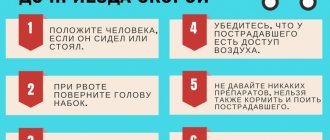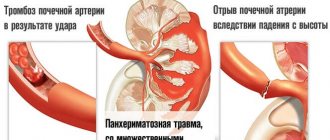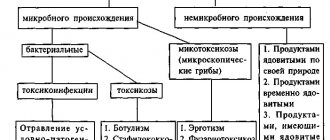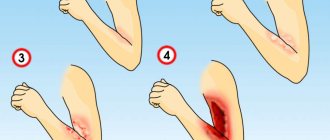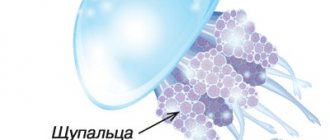Experts distinguish two types of frostbite:
- frostbite as a result of hypothermia of the human body from a long stay in the cold;
- frostbite from local cold damage to certain segments of the skin.
Frostbite is injury to tissue structures under the influence of low temperatures. Severe frostbite is accompanied by spasm of blood vessels and metabolic disorders, and, as a result, oxygen deficiency. To avoid fatal consequences as a result of frostbite, the victim must be provided with proper first aid. If there are all signs of severe frostbite, you should immediately call an ambulance.
Stages of frostbite
Frostbite is divided into 4 stages:
- stage is characterized by redness or whitening of the skin surface, and when warmed it turns blue. The main signs of stage 1 frostbite are slight tingling of the skin or goosebumps.
- The stage is expressed by frostbite of several layers of the skin at once, as a result of which the affected skin segments turn white or blue. As a result, blisters filled with sulfurous liquid appear on the inflamed skin.
- the stage is characterized by damage to all layers of the epidermis. The skin becomes rich red, and in some places becomes burgundy or black. Bubbles containing blood fluid form, which then burst.
- stage is expressed by necrosis of both soft and bone tissues. Often, at stage 4 of frostbite, the first symptoms of gangrene appear.
The main symptoms of frostbite in the body
It should be noted that it is quite difficult to immediately establish the stage of frostbite. It is easiest to detect signs of frostbite on the extremities (fingers and toes); slightly less often the ears, nose and cheeks are affected by frostbite. From prolonged exposure to the cold, a person begins to feel a slight tingling of the skin, after which it gradually becomes numb. This serves as the first alarm bell, meaning that the skin structure does not receive enough oxygen and gradual atrophy occurs, during which the frostbitten person does not even feel pain.
First aid rules for frostbite
The consequences of excessive hypothermia of the human body can be fatal and it is for this reason that timely and competent first aid is extremely important.
- Evacuation of the victim from a cold area, while avoiding rapid warming. If the room is too warm, then it is recommended to apply a bandage to the damaged skin surface to gradually warm the body, since rapid temperature changes can aggravate the situation.
- Numb fingers and toes should not be rubbed. Because at the stage of tissue death this will worsen the situation. In this case, it is better to apply a bandage or hold it under slightly cool (NOT hot!) running water. IMPORTANT!!! Rubbing, as well as warming in warm water, is permissible only in cases where the skin has not completely lost sensitivity.
- Give plenty of warm liquids (tea with sugar, milk). This will help the body warm up from the inside. It is strictly forbidden to give any alcoholic beverages to a frostbite victim!
It is important to understand that the first actions in case of frostbite should be focused on the gradual restoration of blood circulation in the vessels.
If the area of damaged skin is no larger than the size of a person’s palm and after warming procedures normal sensitivity has returned to the receptors, then the help of a specialist in this case may not be required. But if the numbness does not go away for a long time and is accompanied by pain, then you should consult a doctor immediately.
Frostbite - signs, degrees and first aid for frostbite
Frostbite (frostbite) is tissue damage that occurs at low temperatures (usually below −10 ºC). It can be observed even at zero ambient temperature - in cases where large heat losses occur per unit time.
First of all, protruding and insufficiently protected parts of the body are exposed to aggressive influence: ears, nose, cheeks, hands, feet. Subsequently, general hypothermia of the body develops with a decrease in body temperature to critical levels.
Risk factors that reduce the effectiveness of thermoregulation and contribute to the development of frostbite:
— increased heat transfer (sharp wind, high humidity, light clothing);
— local microcirculation disorder (tight shoes, prolonged immobility, forced body position);
— concomitant conditions that weaken the body’s resistance to extreme influences (injuries, blood loss, physical or emotional exhaustion, stress);
- vascular diseases.
The greatest risk of frostbite, according to statistics, is for persons under the influence of alcohol (severe or moderate severity). This is due to partial or complete disorientation, a slower response to stimuli, and a specific vegetative background.
Degrees and signs of frostbite.
Depending on the duration and intensity of aggressive exposure, as well as on the nature of tissue damage, 4 degrees of frostbite are distinguished.
The initial manifestations are similar in all cases (which does not allow us to reliably determine the degree of frostbite in the first hours after the injury):
- pale and cold skin;
- decreased sensitivity.
After the appearance of the first general symptoms, symptoms specific to each degree of frostbite develop
1 Degree of frostbite.
It is characterized by mild soreness of the skin; after warming, intense redness and slight swelling are noted; peeling of the affected areas is possible without the development of necrosis. After 5-7 days, skin manifestations completely disappear.
2 Degree of frostbite.
Within 24-48 hours, blisters of various sizes appear on damaged areas of the skin, filled with transparent (serous) contents. The pain is intense, characterized by itching and burning of the injured skin. With proper treatment, the skin condition is restored within 7-14 days, and there are no scar deformities at the site of the lesion.
3 Degree of frostbite.
Necrosis of the damaged skin occurs, which leads to loss of sensitivity and the formation, after warming, of massive painful blisters with a purplish-bluish base, filled with bloody contents. Subsequently, the blisters necrotize and are rejected with the formation of scars and granulations. Scarring can last up to a month, and rejection of the nail plates also occurs, sometimes irreversibly.
4 Degree of frostbite.
It manifests itself as total necrosis of not only the skin, but also the underlying soft tissues (up to the bones and joints). The injured areas of the skin are cyanotic, after warming a sharply increasing swelling forms, there are no blisters, the sensitivity of the skin is not restored after warming, and gangrene subsequently develops. The affected areas are subject to amputation.
With prolonged exposure to low temperatures, general hypothermia is possible, as evidenced by a decrease in body temperature to 34 ºC or lower (up to 29-30 ºC in severe cases). Depending on the severity, the condition manifests itself as depression of the respiratory, cardiovascular and nervous systems of varying intensity, up to coma and death.
First aid for frostbite.
In case of damage of any intensity, it is first necessary to deliver the victim to a warm room as soon as possible. If there is a possibility of re-frostbite, the damaged part of the body should not be allowed to thaw; otherwise, you should cover it carefully. Further measures depend on the degree of frostbite.
For frostbite of 1st degree you need:
- warm the affected areas of the skin (by breathing, gentle rubbing with a soft woolen cloth or hands);
- Apply a warming cotton-gauze bandage in several layers.
- give hot tea, warm milk, fruit drink to drink.
For frostbite of 2-4 degrees you need:
- exclude rapid warming (massage, rubbing);
- apply a heat-insulating bandage (bandage and cotton wool in several layers, you can use scarves, woolen fabric, shawls);
- fix the frostbitten limb;
- Call an emergency medical team.
It is recommended to give the victim a hot drink and food; you can take Aspirin, Analgin with Papaverine or No-shpa to improve blood microcirculation.
In case of frostbite it is strictly prohibited:
- give the victim coffee and alcohol to drink, which can aggravate the situation;
- rub the frostbitten surface with snow or hard cloth (there is a high probability of injury and subsequent infection of the damaged skin);
- expose the frostbite site to intense heat (using a hot bath, heating pad, heater, etc.);
- rub damaged skin with oil, fat, alcohol, as this can complicate the course of the disease;
— independently open the blisters and remove necrotic tissue.
When should you see a doctor?
At home, only 1st degree frostbite can be treated; in all other cases it is necessary to seek specialized help.
In case of frostbite of the 2nd degree, the blisters are opened and treated in a surgical room. To prevent infection, an aseptic dressing is applied and appropriate therapy is prescribed.
In case of frostbite of 3-4 degrees in a hospital setting, necrotic tissue is removed and anti-inflammatory and antibacterial therapy is carried out.
Features of frostbite in children.
In children, frostbite develops much faster than in adults, which is due to the structure of the skin and its blood supply.
The situation is aggravated by the inability of a child (especially a younger one) to critically assess his condition. Continuing to be outside can make the damage worse.
Redness of exposed areas of the face during a walk is a normal reaction of skin vessels to environmental influences. A warning sign is sudden pallor of the skin: this may indicate developing frostbite.
Prevention of frostbite
To prevent hypothermia and cold damage to soft tissues, several rules should be followed:
- do not drink alcohol outdoors in cold weather;
- smoking also makes a person more vulnerable;
- do not use tight shoes and light clothing, as the layer of air slows down cooling;
- wear a hat, mittens and scarf;
— when going outside in winter, do not wear metal jewelry;
— in cold weather, periodically examine the face, especially the tip of the nose, and limbs;
- at the first signs of frostbite, try to return to a warm room;
- do not wet the skin, as this will increase heat loss.
Particular attention should be paid to young children and the elderly, because their thermoregulation system usually does not work at full capacity. It is not advisable for them to stay outside in severe frosts for more than 20 minutes at a time.
"Iron" frostbite
The so-called “iron” frostbite is a cold injury that develops as a result of contact of warm skin with a very cold metal object. For example, it is not uncommon for children to have their tongues stuck to a street fence or other metal structure.
First aid for “iron” frostbite:
1. If a child sticks his tongue to metal, it is advisable to pour warm water over the grip area to avoid serious injury. If there is no water, you need to use warm breath. The heated metal usually releases its “victim”.
2. Disinfect the affected area - first rinse it with warm water, then, if it is not the tongue, treat the wounds with hydrogen peroxide. This product, thanks to its oxygen bubbles, will remove all dirt from the wound.
3. Stop the bleeding, which can be done with a hemostatic sponge or sterile bandage
4. If the injury is serious or deep, consult a doctor.
Prevention of frostbite
It is possible to avoid serious frostbite if you carefully follow a few simple recommendations:
- wear not only warm pants and jackets on the street, but also a scarf, gloves and a hat
- During the winter season, it is best to wear loose shoes and not wear light clothing
- avoid drinking alcohol outdoors in extremely cold temperatures
- Before going out into the cold, you should not wear a large amount of metal jewelry
- If you notice the first signs of frostbite, you need to go to a warm room as soon as possible
- try to avoid getting water on the skin, as moisture increases heat loss in the body
Adults need to be especially careful about young children who like to play in the cold. They are vulnerable to frostbite because their body's thermoregulation system works on a slightly different principle than that of adults. In addition, frostbite often occurs in older people over 65 years of age, since their thermoregulation system is weaker than that of middle-aged people.
During periods of extremely low temperatures, it is not recommended to stay outdoors for more than 20 minutes.
Degrees of body hypothermia
1st degree of hypothermia (mild) - occurs if body temperature drops to 32-34 degrees. The skin becomes pale, chills, difficulty speaking, and goose bumps appear. Blood pressure remains normal; if it increases, it is only slightly. With mild hypothermia, frostbite of different parts of the body, 1-2 degrees, is already possible.
2nd degree of hypothermia (medium) - entails a decrease in body temperature to 29-32 degrees. At the same time, the pulse slows down significantly - up to 50 beats per minute. The skin becomes bluish and cold to the touch. Blood pressure decreases slightly, and breathing becomes shallow and rare. Often with moderate hypothermia, sudden drowsiness occurs. It is categorically impossible to allow one to sleep in such conditions, because energy production during sleep decreases significantly, and a person in such a state can die. At this stage of hypothermia, frostbite of 1-4 degrees is possible.
Stage 3 hypothermia (severe) - body temperature drops below 31 degrees. The person is already losing consciousness, his pulse slows down to 36 beats per minute. Cramps and vomiting often occur. Breathing becomes very rare - up to 3-4 per minute. Acute oxygen starvation of the brain occurs. Frostbite at this degree of hypothermia is very severe, and if immediate help is not provided, rigor and death will occur.
A red nose is better than a white one
The most commonly affected areas of the body are:
- nose,
- ears,
- cheeks,
- chin,
- fingers.
The first signs of frostbite usually go unnoticed. At first the child complains of a burning or tingling sensation, but later he simply stops feeling anything. As a rule, children do not pay attention to this and continue to walk. Therefore, parents should know what frostbitten areas of skin look like.
A pink blush on the cheeks of a running and jumping child is completely normal. This is how the body warms itself up. Redness of the skin indicates dilation of blood vessels and increased blood flow to the tissues. But the pallor that replaced the blush is already a clear sign of frostbite.
The blood vessels narrow, the protective forces dry up, and the body stops coping with the cold. At the same time the skin:
- loses sensitivity
- becomes hard to the touch.
You will not notice any other signs of frostbite, but its severity will increase in direct proportion to the time spent outside.
Cold damage is very insidious. No, even the most qualified, doctor will be able to immediately determine their severity. Only after warming up does the affected area begin to hurt, swelling and blisters appear on the skin.
Moreover, there is a strict pattern: the more time passes before these signs appear, the greater the likelihood that deep tissues are damaged.
Causes of frostbite
Of course, cold is the main cause of frostbite. But a child can get frostbite even at zero degrees if:
- strong wind,
- high air humidity,
- wet clothes and shoes,
which significantly increase heat loss by the body. Long walks in inclement weather are especially dangerous.
The state of the child’s health also plays a major role: children with skin diseases such as exudative diathesis are more likely to get frostbite. Viral infections, excessive school workload, physical fatigue - all this weakens the body's resistance to cold.
Paradoxically, frostbite occurs even in the youngest children, who are always under the supervision of their parents. I remember well the case of a baby getting frostbite on... the balcony, where he was taken in a stroller to get some fresh air. The baby's vascular system is still very imperfect and is not able to withstand the onslaught of cold for long.
Degrees of frostbite in the body
— Frostbite of the first degree (the mildest) — usually occurs with short-term exposure to cold. The first signs of such frostbite are a burning sensation, tingling sensation followed by numbness of the affected area.
- Frostbite of the second degree - occurs with longer exposure to cold. In the initial period there is pallor, coldness, loss of sensitivity, but these phenomena are observed with all degrees of frostbite. Therefore, the most characteristic sign is the formation of blisters filled with transparent contents in the first days after injury.
- Frostbite of the third degree - the duration of the period of cold exposure and decrease in temperature in the tissues increases. The blisters that form in the initial period are filled with bloody contents, their bottom is blue-purple, insensitive to irritation.
- Frostbite of the IV degree - occurs with prolonged exposure to cold, the decrease in temperature in the tissues is the greatest. It is often combined with frostbite of the third and even second degree. The damaged area of the limb is sharply bluish, sometimes with a marbled coloration. Swelling develops immediately after warming and increases rapidly. The absence of blisters with significantly developed edema and loss of sensitivity indicate degree IV frostbite.
First aid for burns
First aid for burns consists of eliminating the negative factor: you need to move away the source of electric current, wash off the chemical, cover the body from the sun, etc.
You can reduce the pain from a burn by using cold water or an ice pack, this will help reduce the severity of the damage. Apply a dry, sterile dressing, such as a bandage or clean cotton cloth, to the affected surface.
Treatment of burns
A traumatologist will treat the affected area.
For example, a wound resulting from a chemical burn is treated with a neutralizing substance (if the burn was caused by lime, then glucose is used).
Next, the doctor removes part of the non-viable skin and adhered fragments of clothing from the wound, removes blisters, and applies a dry sterile bandage or ointment mesh bandage to the wound. When treating burns, painkillers, a course of antibiotics, and a tetanus shot are prescribed.
General hypothermia
Left to their own devices, careless little girls can fall into an ice hole, splash into an unfrozen puddle or stream. The passion for a good roll in the snow also does not lead to good things. But sometimes it’s not just a child’s prank that leads to misfortune.
In my practice, there was a case when a child was brought in with general hypothermia, whom the teacher forced to sit on a bench for a long time as punishment. The youngest children especially suffer from frost - their bodies have not yet learned to regulate heat exchange.
It is easy to recognize general hypothermia of the body:
- the child is shaking,
- his skin is pale, cold to the touch and covered with goosebumps,
- the baby may be too talkative or, on the contrary, sleepy,
- speech becomes abrupt, the child drawls and has difficulty pronouncing words,
- If you measure your body temperature, it will be lowered to almost 35 degrees.
A warm bath can also help warm up a hypothermic child. You just need to take it for at least an hour. After this, the baby needs to be warmly covered and put to bed. However, remember that general hypothermia is fraught with very serious complications - from deep local frostbite to severe pneumonia.
Cardiac dysfunction is also possible. Therefore, it is better to play it safe and take the child to the hospital.
Signs of frostbite
Let's look at the signs indicating that a child has suffered frostbite:
- pale skin covered with goosebumps;
- cold skin with white spots on it;
- the child begins to behave in an unusual way: talking excessively or feeling drowsy;
- speech may become abrupt and words difficult to pronounce;
- loss of skin sensitivity;
- decrease in body temperature.

